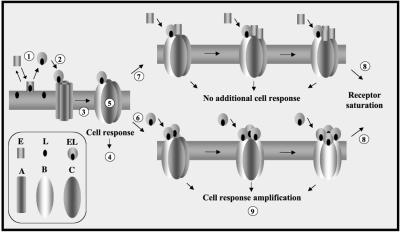Figure 6.
Hypothetical scheme showing the cooperative interaction of elicitin-sterol complex with the elicitin receptor located on the plasma membranes. E and L represent the elicitin and its ligand; EL is the loaded form of elicitins (step 1), which is the sole form able to activate a receptor subunit; A, B, and C are three conformational states of the elicitin receptor subunits. In this scheme, four subunits participate in the multimeric structure. When EL binds to an A (step 2), it leads to the conformational change of this subunit to B (step 3). This new state triggers the biological response (step 4) and allows the conformational change of the other subunits (step 5; C, cooperative effect). C can bind either loaded (EL; step 6) or unloaded (E; step 7) elicitins. This explains why all elicitins are able to saturate the receptor subunits (step 8). However, only EL (B) will trigger a new set of biological responses (step 9).

